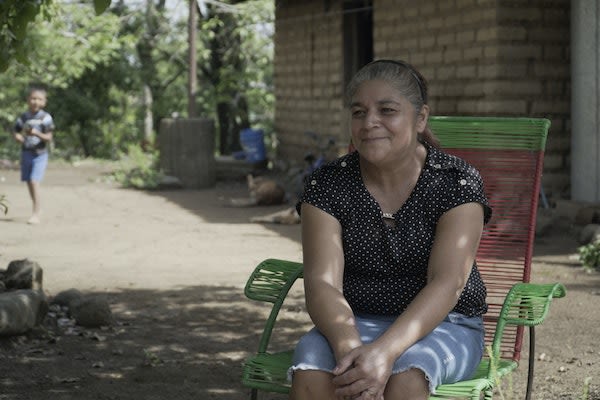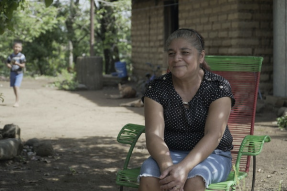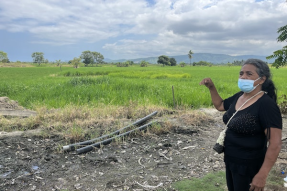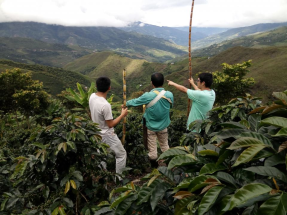Sowing seeds, reaping stability: How Kiva loans help sustain Deysi and her family
December 27, 2022
Many years ago, farmers in El Salvador used to pay children to run through the fields and shout to keep birds and animals away from the crops, Kiva borrower Deysi says.
Such practices are no longer necessary for a successful harvest, she assures. Deysi has been harvesting bushels of sorghum, corn, beans, and apples from her plot of land in the municipality of Jucuapa since she was a young woman.
“Nowadays, with the advancements of technology, you put some insecticide on the seed, and it lasts for 40 days,” says the lifelong farmer.
“By then, the plant has already grown, so it's no longer bothered by [worms or birds.]”
Deysi’s expertise in agriculture extends to more than the latest scientific applications or how long it takes to sow an apple tree. Knowing that yields can vary from year to year, she regularly accesses Kiva loans to help her and her family plan for the future, whatever the season may bring.
“With the loans we got, we felt things were more favorable and we could buy everything in preparation for the harvest,” she says.
“If you think right, you make it through.”
Sowing seeds for growth
“One time—I’m not kidding—from a hectare, we got 14 bags of beans, just the two of us, my husband and me.”
In a country with gender inequity and where poverty, food insecurity, and violence have forced thousands to flee, Deysi’s story is a bright light in El Salvador. At 18, she married her husband and began farming alongside him on a piece of property they owned as they raised their family.
“We understood each other, we always worked well together, we continued to do so with our children,” says Deysi, who is now 60 and a grandmother of nine.
“I learned everything about my work with my husband, and we taught the children. We showed them also from a young age. We educated them, but also gave them work, so that they could learn.”
At the beginning, however, it was just the couple preparing the soil, planting the crops, and chasing off the birds. They had a few cows, leveraging them to buy fertilizer and equipment because there was no other capital for them to borrow.
“When we started to work, there was nowhere you could get a credit,” Deysi recalls.
“There weren’t as many things,” she says, referring to both the lack of modern agricultural tools and the scarcity of available funding for farmers like herself and her husband.
Then, with a small loan from Kiva Lending Partner CrediCampo, which began as an offshoot of the El Salvadorian social institution Fundación Campo, Deysi and her husband were able to purchase what they needed to stabilize and grow their agricultural venture.
“Over time, those foundations started, and we felt a little better, because when you have a good harvest, you notice that you get a better income and you can save,” she says.
Her husband insisted on a conservative approach to borrowing, first setting aside enough of the harvest to feed the family and then selling enough to pay off the loans before trying to turn a profit. By saving and working, they learned to create a stable income with their land, little by little.
“That’s how we made progress,” Deysi describes, acknowledging that during the bad years, the institution was there to help. There were also plenty of good years, when the couple reaped wonderful benefits from their work.
“One time—I’m not kidding—from a hectare, we got 14 bags of beans, just the two of us, my husband and me.”
Borrower Spotlight: How Neriman turned ‘few into plenty’
A legacy of repaying Kiva loans
 Deysi with 3 of her 9 grandchildren
Deysi with 3 of her 9 grandchildren Since her husband passed away, Deysi has continued her commitment to farming the land—and to the cycle of borrowing and paying off loans. Three of her five grown children work with her to see each harvest through to its fruition, preparing the land and portioning the gathered crops to store and to sell.
"Everyone knows what they must do," says the sensible matriarch.
“Some paint the seeds…Someone plows to furrow the land, others deal with all the fertilizers that we’re going to use in the sowing.”
Each year she takes out a new loan to invest in production, the latest funded by 38 Kiva lenders. Like her husband before her, she upholds the practice of paying it off promptly, so “I know I’ll have the doors open next year.”
While repayment is a priority, so is strict adherence to spending the money on exactly for what it was planned.
“If you invest the money in something else, you’ll be stressed out when it’s time to plant,” she forewarns.
“If I ask for a loan for agriculture but I start building a house instead, I won’t see results. My harvest will be poor because I didn’t invest it in my production.”
Deysi holds this consistency as the foundation of the farm’s longevity and success.
“This is how my husband and I have worked all our lives. Sometimes, we had bad results because we had bad years, but not because we didn’t invest the money in the harvest,” she says of their philosophy.
“We have been working with CrediCampo for a long time, since the program started here, and thank God, we have never failed them. We have always been on time.”
Learn more about Deysi’s story here:
Loans for the next generation
“If you think right, you make it through.”
Agriculture has progressed tremendously since children used to race through the fields acting as scarecrows, though Deysi upholds that hard work and wise investing will always be important practices. Her daughter has already borrowed and paid off her first loan, and the caring grandmother hopes all of her family will take the business lessons she and husband have instilled and apply them to future harvests.
“I tell my children and grandchildren that in order to manage the money from a loan, they must also know how to think things through,” she says.
“I talk about that with them and say, ‘learn how to invest, learn how to think things through like your father always did. That's how I want you to be.’”
Thinking about helping someone invest in their success? Make a loan today!
PREVIOUS ARTICLE
Catherine is a skilled artisan from Ghana. A Kiva loan helped her grow her business and teach the trade to others. →NEXT ARTICLE
The results are in: Find out how Kiva is impacting financial outcomes for US borrowers →













